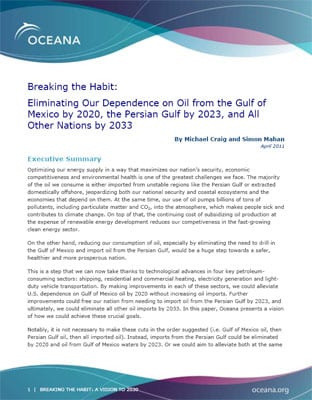Report | April, 2011
Breaking the Habit: Eliminating Our Dependence on Oil from the Gulf of Mexico by 2020, the Persian Gulf by 2023, and All Other Nations by 2033
Optimizing our energy supply in a way that maximizes our nation’s security, economic competitiveness and environmental health is one of the greatest challenges we face. The majority of the oil we consume is either imported from unstable regions like the Persian Gulf or extracted domestically offshore, jeopardizing both our national security and coastal ecosystems and the economies that depend on them. At the same time, our use of oil pumps billions of tons of pollutants, including particulate matter and CO2, into the atmosphere, which makes people sick and contributes to climate change. On top of that, the continuing cost of subsidizing oil production at the expense of renewable energy development reduces our competiveness in the fast-growing clean energy sector.
On the other hand, reducing our consumption of oil, especially by eliminating the need to drill in the Gulf of Mexico and import oil from the Persian Gulf, would be a huge step towards a safer, healthier and more prosperous nation.
This is a step that we can now take thanks to technological advances in four key petroleum-consuming sectors: shipping, residential and commercial heating, electricity generation and light-duty vehicle transportation. By making improvements in each of these sectors, we could alleviate U.S. dependence on Gulf of Mexico oil by 2020 without increasing oil imports. Further improvements could free our nation from needing to import oil from the Persian Gulf by 2023, and ultimately, we could eliminate all other oil imports by 2033. In this paper, Oceana presents a vision of how we could achieve these crucial goals.
Notably, it is not necessary to make these cuts in the order suggested (i.e. Gulf of Mexico oil, then Persian Gulf oil, then all imported oil). Instead, imports from the Persian Gulf could be eliminated by 2020 and oil from Gulf of Mexico waters by 2023. Or we could aim to alleviate both at the same time, and achieve that goal by 2023. Rather, the key message of this vision is that we, as a nation, have the very real opportunity to fundamentally change our relationship with oil. By making the changes discussed below as soon and as aggressively as possible, we can eliminate the need for offshore drilling and oil imports in just over 20 years – which would be a momentous and valuable accomplishment.
How much change we need in each sector depends of course on how much we make in the others. This paper presents just one scenario, or one set of targets, that, if met, would achieve our three goals (Table 1; Fig. 1). Ultimately, though, many other formulas could be created by either increasing or decreasing the amount of change made in the four sectors; by tackling other sectors, such as commercial trucking; or by adopting energy conservation practices. Regardless of the path we choose, it is clear that we could eliminate our dependence on oil from Gulf of Mexico waters by the end of this decade, the Persian Gulf just three years later, and all other imports by 2033.




